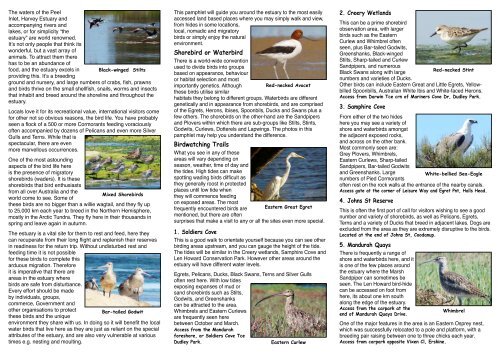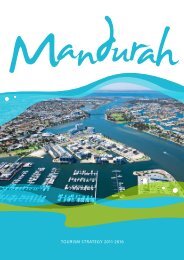Birdwatching Trail Guide - Mandurah Visitor Centre
Birdwatching Trail Guide - Mandurah Visitor Centre
Birdwatching Trail Guide - Mandurah Visitor Centre
Create successful ePaper yourself
Turn your PDF publications into a flip-book with our unique Google optimized e-Paper software.
The waters of the Peel<br />
Inlet, Harvey Estuary and<br />
accompanying rivers and<br />
lakes, or for simplicity “the<br />
estuary” are world renowned.<br />
It’s not only people that think its<br />
wonderful, but a vast array of<br />
animals. To attract them there<br />
has to be an abundance of<br />
food, and the estuary excels in Black-winged Stilts<br />
providing this. It’s a breeding<br />
ground and nursery, and large numbers of crabs, fish, prawns<br />
and birds thrive on the small shellfish, snails, worms and insects<br />
that inhabit and breed around the shoreline and throughout the<br />
estuary.<br />
Locals love it for its recreational value, international visitors come<br />
for other not so obvious reasons, the bird life. You have probably<br />
seen a flock of a 500 or more Cormorants feeding voraciously<br />
often accompanied by dozens of Pelicans and even more Silver<br />
Gulls and Terns. While that is<br />
spectacular, there are even<br />
more marvellous occurrences.<br />
One of the most astounding<br />
aspects of the bird life here<br />
is the presence of migratory<br />
shorebirds (waders). It is these<br />
shorebirds that bird enthusiasts<br />
from all over Australia and the<br />
Mixed Shorebirds<br />
world come to see. Some of<br />
these birds are no bigger than a willie wagtail, and they fly up<br />
to 25,000 km each year to breed in the Northern Hemisphere,<br />
mostly in the Arctic Tundra. They fly here in their thousands in<br />
spring and leave again in autumn.<br />
The estuary is a vital site for them to rest and feed, here they<br />
can recuperate from their long flight and replenish their reserves<br />
in readiness for the return trip. Without undisturbed rest and<br />
feeding time it is not possible<br />
for these birds to complete this<br />
arduous migration. Therefore<br />
it is imperative that there are<br />
areas in the estuary where<br />
birds are safe from disturbance.<br />
Every effort should be made<br />
by individuals, groups,<br />
commerce, Government and<br />
other organisations to protect<br />
these birds and the unique<br />
Bar-tailed Godwit<br />
environment they share with us. In doing so it will benefit the local<br />
water birds that live here as they are just as reliant on the special<br />
attributes of the estuary, and are also very vulnerable at various<br />
times e.g. nesting and moulting.<br />
This pamphlet will guide you around the estuary to the most easily<br />
accessed land based places where you may simply walk and view,<br />
from hides in some locations,<br />
local, nomadic and migratory<br />
birds or simply enjoy the natural<br />
environment.<br />
Shorebird or Waterbird<br />
There is a world-wide convention<br />
used to divide birds into groups<br />
based on appearance, behaviour<br />
or habitat selection and most<br />
importantly genetics. Although<br />
Red-necked Avocet<br />
these birds utilise similar<br />
habitats they belong to different groups. Waterbirds are different<br />
genetically and in appearance from shorebirds, and are comprised<br />
of the Egrets, Herons, Ibises, Spoonbils, Ducks and Swans plus a<br />
few others. The shorebirds on the other-hand are the Sandpipers<br />
and Plovers within which there are sub-groups like Stilts, Stints,<br />
Godwits, Curlews, Dotterels and Lapwings. The photos in this<br />
pamphlet may help you understand the difference.<br />
<strong>Birdwatching</strong> <strong>Trail</strong>s<br />
What you see in any of these<br />
areas will vary depending on<br />
season, weather, time of day and<br />
the tides. High tides can make<br />
spotting wading birds difficult as<br />
they generally roost in protected<br />
places until low tide when<br />
they will commence feeding<br />
on exposed areas. The most<br />
frequently encountered birds are Eastern Great Egret<br />
mentioned, but there are often<br />
surprises that make a visit to any or all the sites even more special.<br />
1. Soldiers Cove<br />
This is a good walk to orientate yourself because you can see other<br />
birding areas upstream, and you can gauge the height of the tide.<br />
The tides will be similar in the Creery wetlands, Samphire Cove and<br />
Len Howard Conservation Park. However other areas around the<br />
estuary will have different water levels.<br />
Egrets, Pelicans, Ducks, Black Swans, Terns and Silver Gulls<br />
often rest here. With low tides<br />
exposing expanses of mud or<br />
sand shorebirds such as Stilts,<br />
Godwits, and Greenshanks<br />
can be attracted to the area.<br />
Whimbrels and Eastern Curlews<br />
are frequently seen here<br />
between October and March.<br />
Access from the <strong>Mandurah</strong><br />
foreshore, or Soldiers Cove Tce<br />
Dudley Park.<br />
Eastern Curlew<br />
2. Creery Wetlands<br />
This can be a prime shorebird<br />
observation area, with larger<br />
birds such as the Eastern<br />
Curlew and Whimbrel often<br />
seen, plus Bar-tailed Godwits,<br />
Greenshanks, Black-winged<br />
Stilts, Sharp-tailed and Curlew<br />
Sandpipers, and numerous<br />
Red-necked Stint<br />
Black Swans along with large<br />
numbers and varieties of Ducks.<br />
Other birds can include Eastern Great and Little Egrets, Yellowbilled<br />
Spoonbills, Australian White Ibis and White-faced Herons.<br />
Access from Darwin Tce crn of Mariners Cove Dr, Dudley Park.<br />
3. Samphire Cove<br />
From either of the two hides<br />
here you may see a variety of<br />
shore and waterbirds amongst<br />
the adjacent exposed rocks,<br />
and across on the other bank.<br />
Most commonly seen are:<br />
Grey Plovers, Whimbrels,<br />
Eastern Curlews, Sharp-tailed<br />
Sandpipers, Bar-tailed Godwits<br />
and Greenshanks. Large<br />
White-bellied Sea-Eagle<br />
numbers of Pied Cormorants<br />
often rest on the rock walls at the entrance of the nearby canals.<br />
Access gate at the corner of Leisure Way and Egret Pnt, Halls Head.<br />
4. Johns St Reserve<br />
This is often the first port of call for visitors wishing to see a good<br />
number and variety of shorebirds, as well as Pelicans, Egrets,<br />
Terns and a variety of Ducks that breed in adjacent lakes. Dogs are<br />
excluded from the area as they are extremely disruptive to the birds.<br />
Located at the end of Johns St, Coodanup.<br />
5. <strong>Mandurah</strong> Quays<br />
There is frequently a range of<br />
shore and waterbirds here, and it<br />
is one of the few places around<br />
the estuary where the Marsh<br />
Sandpiper can sometimes be<br />
seen. The Len Howard bird-hide<br />
can be accessed on foot from<br />
here, its about one km south<br />
along the edge of the estuary.<br />
Access from the carpark at the<br />
end of <strong>Mandurah</strong> Quays Drive.<br />
Whimbrel<br />
One of the major features in the area is an Eastern Osprey nest,<br />
which was successfully relocated to a pole and platform, with a<br />
breeding pair raising between one to three chicks each year.<br />
Access from carpark opposite Vixen Cl, Erskine.



